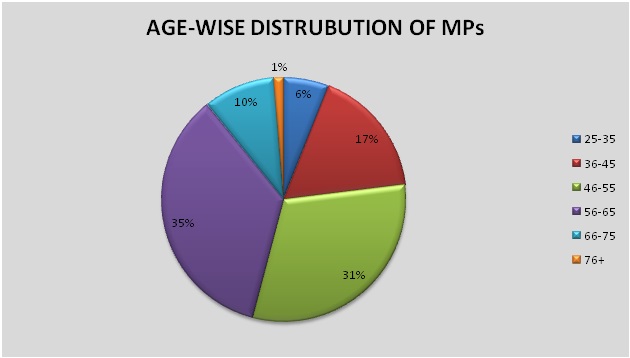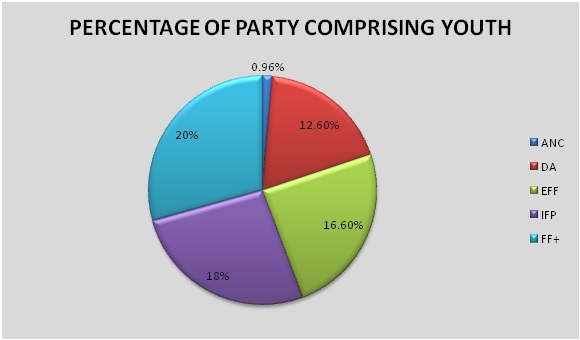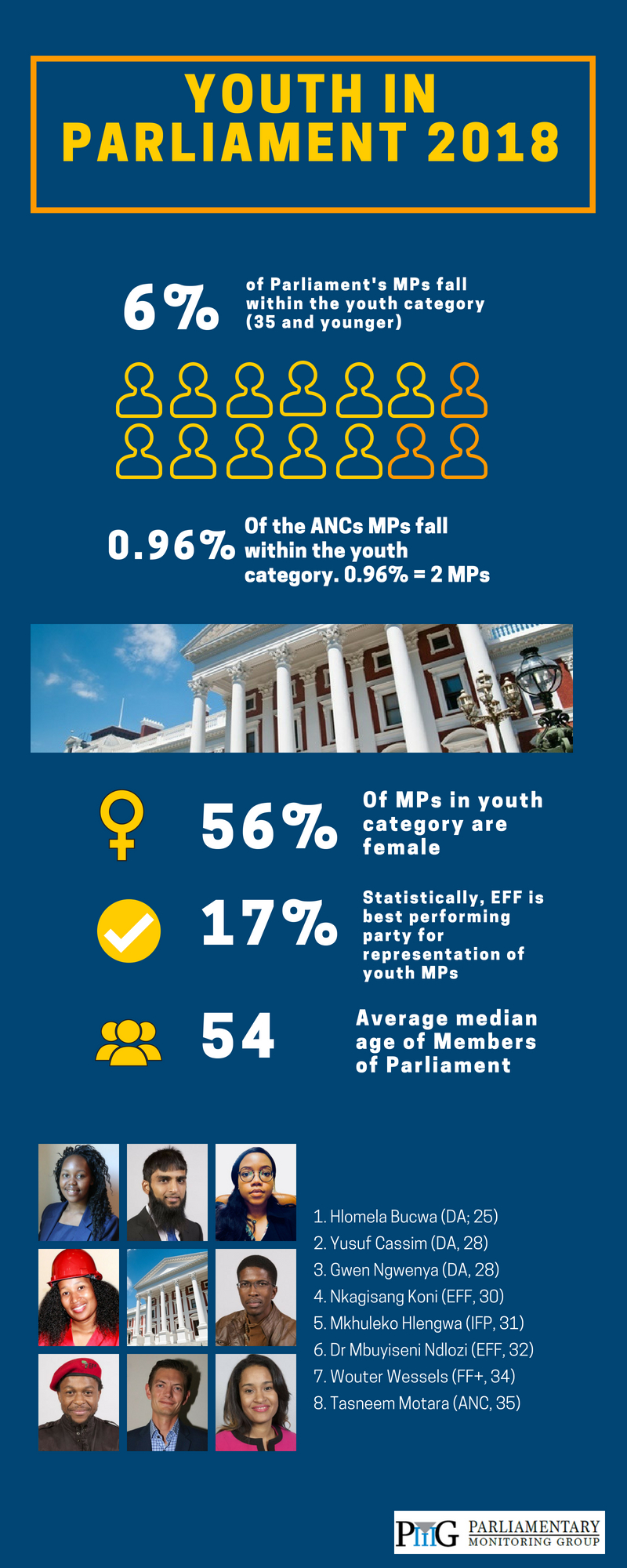Youth in Parliament 2018
Saturday, 16 June 2018, marks Youth Day and an ideal opportunity to reflect on the ages of our Members of Parliament. In South Africa, our definition of youth is someone under the age of 35[1]. We are often told that SA has a young population so it is worth reflecting on the age composition of Parliament and if this is reflected in this body.
Becoming an MP can be a complex and difficult journey. In many respects, the job is viewed as one which requires experience. It could be argued this naturally favours older people. South Africa's Parliament, particularly the ANC benches, frequently face criticism for the majority of their caucus comprises of older Members, especially compared to the opposition. This was seen during the 2018 Youth Day debate in the National Assembly where, in his straw survey, Honourable Hlengwa found most of the MPs falling within the youth category were found on the opposition benches – is this accurate?
The Parliamentary Monitoring Group obtained the birthdates of all current Members of Parliament, with the exception of Ministers and Deputy Ministers. The importance of youth in representative politics and the scarcity of information on the ages of Members in Parliament in South Africa, led PMG to conduct this mini-study.
From the data collated, PMG has found that the average median age of Members of Parliament is 54 years.

Statistically, the DA has the largest number of young MPs between 25-35 but is outperformed by the EFF and IFP proportionally.
PMG’s findings show only 23 MPs fall under the category of youth (35 and younger) – 18 of these MPs are in the National Assembly and the remaining 5 are in the NCOP. This category of youth makes up 6% of all Members of Parliament.
The breakdown per party is as follows:

Of the 23 MPs falling within the category of youth, the breakdown by gender is promising, 13 of the MPs are female and 10 are male.
|
AGE COHORT |
NUMBER OF MPs |
PERCENTAGE |
|
23-35 |
23 |
6% |
|
36-45 |
63 |
17% |
|
46-55 |
118 |
31% |
|
56-65 |
133 |
35% |
|
66-75 |
36 |
10% |
|
76-79 |
5 |
1% |
Interested in who some of our young MPs are? Let’s look at the youngest MPs per party
- Hlomela Bucwa (DA) 25
- Gwen Ngwenya (DA) 28
- Nkagisang Koni (EFF) 30
- Mkhuleko Hlengwa (IFP) 31
- Mbuyiseni Ndlozi (EFF) 33
- Wouter Wessels (FF+) 34
- Tasneem Motara (ANC) 35
|
AGE COHORT PER PARTY |
|||||||||||
|
25-35 |
36-45 |
46-55 |
56-65 |
66-75 |
76-79 |
||||||
|
ANC |
2 |
ANC |
27 |
ANC |
78 |
ANC |
75 |
ANC |
21 |
ANC |
4 |
|
DA |
13 |
DA |
17 |
DA |
26 |
DA |
36 |
DA |
11 |
DA |
0 |
|
EFF |
5 |
EFF |
14 |
EFF |
5 |
EFF |
6 |
EFF |
0 |
EFF |
0 |
|
IFP |
2 |
IFP |
2 |
IFP |
1 |
IFP |
4 |
IFP |
1 |
IFP |
1 |
|
FF+ |
1 |
FF+ |
0 |
FF+ |
1 |
FF+ |
3 |
FF+ |
0 |
FF+ |
0 |
|
ACDP |
0 |
ACDP |
0 |
ACDP |
0 |
ACDP |
3 |
ACDP |
0 |
ACDP |
0 |
|
COPE |
0 |
COPE |
0 |
COPE |
1 |
COPE |
1 |
COPE |
1 |
COPE |
0 |
|
AGANG |
0 |
AGANG |
1 |
AGANG |
0 |
AGANG |
1 |
AGANG |
0 |
AGANG |
0 |
|
NFP |
0 |
NFP |
1 |
NFP |
3 |
NFP |
1 |
NFP |
0 |
NFP |
0 |
|
PAC |
0 |
PAC |
0 |
PAC |
0 |
PAC |
1 |
PAC |
0 |
PAC |
0 |
|
APC |
0 |
APC |
0 |
APC |
1 |
APC |
0 |
APC |
0 |
APC |
0 |
|
AIC |
0 |
AIC |
0 |
AIC |
2 |
AIC |
1 |
AIC |
0 |
AIC |
0 |
|
UDM |
0 |
UDM |
1 |
UDM |
0 |
UDM |
1 |
UDM |
2 |
UDM |
0 |
How does this fare against international trends? In the 2016 youth participation in national parliaments study, the Inter-Parliamentary Union[2] found:
- Young people under 30 make up less than 2% of the world’s MPs
- People between the ages of 20 and 44 make up 57% of the world’s voting age population but only 26% of the world’s MPs
- Male MPs outnumber their female counterparts in every age group but is less pronounced in younger age groups where the male/female ratio is 60:40
- Ecuador, Finland, Norway and Sweden are the only parliaments in the world where more than 10% of members are aged under 30
Will the Sixth Parliament be younger? Will the number of new, inexperienced Members be higher than in 2014? The IPU says that there is an urgent need for action to address underrepresentation of youth in the membership of legislatures. This is not self-correcting problem but requires active measures for change. PMG will continue to collect systematic data on the age of parliamentarians to assess progress made.
We will find out in 2019.


